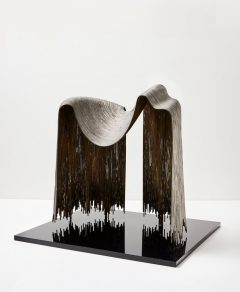
brass and tin on plexiglass base
32 × 35 × 30 cm / 12 5/8 × 13 3/4 × 11 13/16 in
Edition of Unique
Catalogue Raisonné by Költzsch/Schwarz 1992 no. 354
Price includes German VAT. Shipping costs are not included. All prices are subject to change and availability. Change region and currency
The artist’s studio (at least until 1992); Private Collection (acquired directly from the artists)
- Galerie Ludorff, "The Simple Things. Minimalism and more...", Düsseldorf 2024
- Schwabenlandhalle, "1. Triennale Fellbach: Kleinplastik in Deutschland". Fellbach 1980
- Palazzo della Ragione, "11. Biennale Internazionale della Piccola Scultura", Padua 1977
- Galerie Schüler, "Matschinsky-Denninghoff. 12 kleine Skulpturen", Berlin 1976
- Galerie Ludorff, Neuerwerbungen Frühjahr 2021, Düsseldorf 2021
- Georg W. Költzsch (Hg.), "Matschinsky-Denninghoff, Monographie und Werkverzeichnis der Skulpturen", Köln 1992, Nr. 354
- Peter Anselm Riedl, "Eins und doppelt", in: Heidelberger Kunstverein (Hg.), "Matschinsky-Denninghoff M_1:10", Ausst.-Kat. Heidelberg 1984, S. 11-23, S. 15
- "1. Triennale Fellbach: Kleinplastik in Deutschland", Ausst.-Kat. Schwabenlandhalle Fellbach 1980, Nr. 1
- Manfred de la Motte (Hg.), "Matschinsky-Denninghoff", Ausst.-Kat. Galerie Hennemann, Bonn 1980, o.S.
- Galerie Schüler (Hg.), "Matschinsky-Denninghoff. 12 kleine Skulpturen", Leporello zur Ausstellung, Berlin 1976, m. Abb.
Just as the individual elements in their works come together to form a large, homogeneous whole, the work of Martin and Brigitte Matschinsky-Denninghoff cannot be traced back in its entirety to one part of the artist couple. Since 1955, the year of their wedding, they have worked together on the incredibly dynamic metal bodies for which they are still known today. Personalities such as Antoine Pevsner, Henry Moore and later Hans Hartung have had a formative influence on the artistic work of the two artists. Space and time as well as the symbiosis of figuration and abstraction are declared to be the central standards of their art. The works are characterised by static forces, growth and movement, and the variation of the line is the constitutive element at the forefront of their work.
While the inner structure of these spatial lines, especially for the tectonic works of the early years, is created in an extremely complex process, the materials used for the sculpture, mostly metal rods and tubes, are quite simple construction elements. Together they form a flow of movement that would not be possible with a single sheet of iron. Each individual rod is a piece of the whole and an expressive part. Welded together individually, they form the shell of the larger tubular elements and, from 1965 onwards, also form independent structures. Our work ‘Ela’ is a fine example of this type. Created in 1976, it bears witness to a new symbiosis of metal rod elements. Lined up in parallel, the cubic forms are replaced by a two-dimensional element whose fold-like pattern of movement and geophysical attraction to the ground is reminiscent of a cloth thrown over an invisible object.
One might be reminded here of the wrapped buildings and objects of the artist couple Christo and Jean Claude, except that the act of wrapping is taken ad absurdum in Matschinsky-Denninghoff's work. The work presents itself as the wrapping of a supporting object that is not (or no longer) there itself and thus thematises a non-existent physicality that is merely inscribed in the space as an illusion. The sculpture is not simply there, but appears as an active agent, declaring the air and ground to be a space for action and unfolding an event that affects the viewer and actively involves him or her. This is supported by the onomatopoeic titles of the works. They refer to nature and history, myth or technology and evoke figurative associations in their sound. Like the outer impression, ‘Ela’ also sounds soft and floating. The openness of the phonetic image thus corresponds to the mimetic openness of the form. The ancient meaning of the name, which comes from the Hebrew for ‘God’, also reinforces this impression. In the spirit of Henry Moore, over a creative period of four decades, which would have culminated in Martin Matschinsky-Dennighoff's 100th birthday this year, they succeeded in realising the essential sentimental content of forms, instead of merely seeing a representational value in the form with inspiration from nature and the world around them.1
1 Georg W. Költzsch u. Annette Schwarz (Hg.), »Matschinsky- Denninghoff. Monographie und Werkverzeichnis der Skulpturen«, Köln 1992, S.80.





